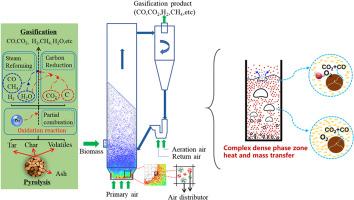Modeling of industrial biomass fluidized bed gasification system and optimization of operating conditions
IF 5.8
2区 生物学
Q1 AGRICULTURAL ENGINEERING
引用次数: 0
Abstract
Carbon emissions from fossil fuel combustion have emerged as a critical constraint on sustainable industrial development. Biomass gasification gas (BGG) represents a promising decarbonization pathway; however, the reliance on single-source biomass cannot ensure the operational reliability of industrial fluidized bed gasifiers. A key challenge to large-scale BGG adoption lies in the limited adaptability of fluidized bed reactors to different biomass, which exhibit heterogeneous physicochemical properties. Moreover, industrial research on the impact of structural parameters on gasification efficiency remains scarce. To investigate the impact of different biomass on gasification performance in fluidized-bed reactors, this study developed an industrial-scale fluidized-bed gasifier model using the Aspen Plus fluidized-bed module, based on an 8 t/h biomass gasifier operating in a regional facility. Key parameters, including equivalence ratio (ER), gasification pressure, and gasification temperature, were systematically evaluated to assess their effects on BGG composition and gasification efficiency. Furthermore, model validity was rigorously validated through computational and experimental data comparisons of critical design parameters. The results demonstrated that gasification temperature and ER are critical factors influencing biomass gasification efficiency. When the gasification temperature increased from 650 to 900 °C, the gas yield variation of corn stover and wooden blocks reached a maximum of 0.17 m3/kg. For corn stover gasification, the volumetric fractions of H2, CO, CO2, and CH4 exhibited an increasing trend, rising by 11.43 %, 8.41 %, 7.73 %, and 2.24 %, respectively. Notably, biomass briquette gasification showed the most significant increase in H2 fraction (11.4 %). Balancing operational safety and efficiency, the optimal gasification temperature was identified as 850 °C, with an ER range of 0.15–0.2. Increased biomass moisture content (2 %–25 %) reduced CH4 concentration from 4.08 % to 2.95 %, lowering the overall BGG calorific value. Air temperature exhibited negligible impacts on gasification performance. Implementation of these findings in industrial biomass gasifiers validated the optimized parameters of the model can accurately predict and guide actual experiments, with <20 % deviation in BGG composition under optimized conditions.

工业生物质流化床气化系统建模及运行条件优化
化石燃料燃烧产生的碳排放已成为制约可持续工业发展的关键因素。生物质气化气体(BGG)是一种很有前途的脱碳途径;然而,对单一来源生物质的依赖并不能保证工业流化床气化炉的运行可靠性。BGG大规模应用的一个关键挑战在于流化床反应器对不同生物质的适应性有限,这些生物质具有异质的物理化学性质。此外,关于结构参数对气化效率影响的工业研究仍然很少。为了研究不同生物质对流化床反应器气化性能的影响,本研究基于一个区域设施中运行的8 t/h生物质气化炉,使用Aspen Plus流化床模块开发了一个工业规模的流化床气化炉模型。系统评价了等效比(ER)、气化压力和气化温度等关键参数对BGG成分和气化效率的影响。此外,通过关键设计参数的计算和实验数据比较,严格验证了模型的有效性。结果表明,气化温度和ER是影响生物质气化效率的关键因素。当气化温度从650℃升高到900℃时,玉米秸秆和木块的产气量变化最大,为0.17 m3/kg。在玉米秸秆气化过程中,H2、CO、CO2和CH4的体积分数呈上升趋势,分别上升11.43%、8.41%、7.73%和2.24%。值得注意的是,生物质型煤气化的H2分数增加最为显著(11.4%)。在兼顾运行安全和效率的基础上,优选出850℃的最佳气化温度,ER范围为0.15 ~ 0.2。增加生物量含水量(2% ~ 25%),使CH4浓度从4.08%降低到2.95%,降低了BGG的总热值。空气温度对气化性能的影响可以忽略不计。在工业生物质气化炉上的实施验证了优化后的模型参数能够准确预测和指导实际实验,优化条件下BGG组成偏差为<; 20%。
本文章由计算机程序翻译,如有差异,请以英文原文为准。
求助全文
约1分钟内获得全文
求助全文
来源期刊

Biomass & Bioenergy
工程技术-能源与燃料
CiteScore
11.50
自引率
3.30%
发文量
258
审稿时长
60 days
期刊介绍:
Biomass & Bioenergy is an international journal publishing original research papers and short communications, review articles and case studies on biological resources, chemical and biological processes, and biomass products for new renewable sources of energy and materials.
The scope of the journal extends to the environmental, management and economic aspects of biomass and bioenergy.
Key areas covered by the journal:
• Biomass: sources, energy crop production processes, genetic improvements, composition. Please note that research on these biomass subjects must be linked directly to bioenergy generation.
• Biological Residues: residues/rests from agricultural production, forestry and plantations (palm, sugar etc), processing industries, and municipal sources (MSW). Papers on the use of biomass residues through innovative processes/technological novelty and/or consideration of feedstock/system sustainability (or unsustainability) are welcomed. However waste treatment processes and pollution control or mitigation which are only tangentially related to bioenergy are not in the scope of the journal, as they are more suited to publications in the environmental arena. Papers that describe conventional waste streams (ie well described in existing literature) that do not empirically address ''new'' added value from the process are not suitable for submission to the journal.
• Bioenergy Processes: fermentations, thermochemical conversions, liquid and gaseous fuels, and petrochemical substitutes
• Bioenergy Utilization: direct combustion, gasification, electricity production, chemical processes, and by-product remediation
• Biomass and the Environment: carbon cycle, the net energy efficiency of bioenergy systems, assessment of sustainability, and biodiversity issues.
 求助内容:
求助内容: 应助结果提醒方式:
应助结果提醒方式:


